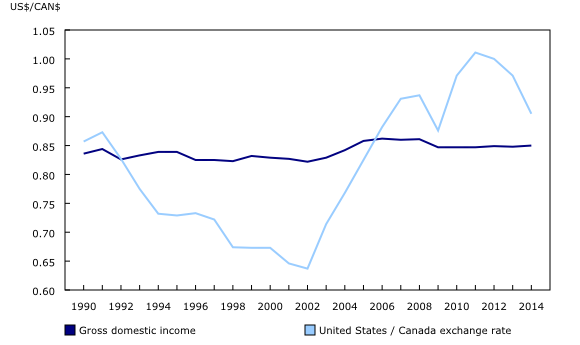Purchasing power parities, 2014
Archived Content
Information identified as archived is provided for reference, research or recordkeeping purposes. It is not subject to the Government of Canada Web Standards and has not been altered or updated since it was archived. Please "contact us" to request a format other than those available.
Released: 2015-11-03
In 2014, the purchasing power parity (PPP) for gross domestic income from the United States / Canada bilateral program was 85.0 US cents per Canadian dollar. Although stable since 2009, this is slightly lower than the peak of 86.2 cents in 2006.
Construction, the largest component of gross fixed capital formation, was the main contributor to the decline. The PPP associated with construction decreased from 82.9 US cents in 2006 to 73.4 US cents in 2014.
With the exception of a slight upward movement from 2003 to 2006, the relative stability of PPPs for gross domestic income over the 2000s suggests that the appreciation in the exchange rate, which started in 2002, did not significantly affect Canadian purchasing power overall.
In 2014, the PPP for actual individual consumption was 86.6 US cents per Canadian dollar. Excluding a significant decline of 1.3% in 2009, this aggregate has remained fairly stable over the past 10 years.
Actual individual consumption represents the largest component of gross domestic product, and is most representative of material well-being at the household level. It includes the goods and services consumed by households, regardless of whether they are produced or paid for by households, governments or non-profit institutions serving households.
Bilateral PPPs show that, in 2014, individual consumption per capita was 23% higher in the United States than in Canada. The difference was particularly notable for non-durable goods, where the consumption per capita was almost 53% higher for American consumers. Durable goods, however, were 10% higher for American consumers.
With the exception of health and education categories, all consumer goods and services purchased in Canada were more expensive than in the United States. This has been the case since the inception of this dataset in 1990.
Note to readers
Data on purchasing power parities (PPPs) for 2012, 2013 and 2014 are now available.
Revisions
With this release, the bilateral Canada / United States program on PPPs was revised back to 1990. These annual revisions from 1990 to 2014 incorporate prices from the Organisation of Economic Cooperation and Development's (OECD) benchmark exercise for 2011. They also include revised current dollar expenditure, and corresponding price indexes from the Canadian System of National Accounts and the United States National Income and Product Accounts. Both Canada (September 2012) and the United States (July 2013) adopted the international System of National Accounts 2008 standard, which is now being used for the first time in the bilateral PPP program.
In addition, the data are now based on the most recent OECD-Eurostat Classification System of National Accounts (Round 2014). This new classification is also consistent with the 2008 System of National Accounts. It is structured by type of final expenditure—individual consumption, collective consumption and capital expenditure. Individual consumption is also categorized by sector: household, non-profit institutions serving households and governments.
These major changes have necessitated a new compilation of expenditure weights for both Canada and the United States, and a reassessment of historical benchmark prices. To insure consistency over time, new methodologies were implemented for the communication, education and health categories.
From 2008 onward, the new Canada / United States database is also supplemented with comparable and representative prices collected from various websites. These added prices are mainly concentrated in semi-durable and durable goods, in machinery and equipment and in individual services.
Updates to PPPs for the multilateral program have also been recompiled to reflect revisions made by the OECD from 1980 to 2014.
Definitions
Purchasing power parities are estimates of the relative purchasing power between two or more currencies. At the most basic level, it is a ratio of prices for a particular commodity in two countries, with the prices expressed in their respective national currencies. Adjusted to a common currency and a common set of prices, they can be used to make international comparisons of the relative volumes of goods and services invested in or consumed. They are calculated by dividing the price of a specific item of a specific quality in one country's currency by the price of the same item in the other country, in the currency of the other country.
United States per capita expenditures in current dollars are converted to Canadian dollars by dividing them by the Fisher PPPs. These converted expenditures are then expressed as a ratio of Canadian expenditures per capita.
Comparative price levels are calculated as the PPPs divided by the exchange rate. They measure the degree to which one country's price level is above or below another's. These ratios indicate the number of units of a common currency needed to buy the same volume of goods and/or services in different countries. The rates produced are also termed "real" exchange rates.
Data for PPPs and related series include consumption (International Comparison Program) and expenditure-based data System of National Accounts from the Canada / United States bilateral program. When making international comparisons, the consumption-based classification is more appropriate, as it is controlled for the various levels of government involvement in the financing of consumption between countries.
Contact information
For more information, or to enquire about the concepts, methods or data quality of this release, contact us (toll-free 1-800-263-1136; 514-283-8300; STATCAN.infostats-infostats.STATCAN@canada.ca) or Media Relations (613-951-4636; STATCAN.mediahotline-ligneinfomedias.STATCAN@canada.ca).
- Date modified:


